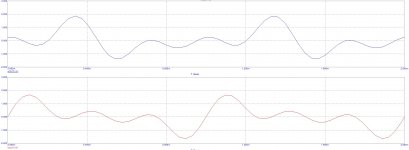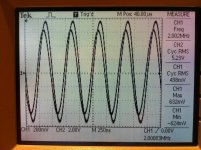What you are saying Elvee is these two signals sounds the same? Very interesting.
These two signals are identical at the input of each of two amps with different phase shifts
I say these two signals would sound very different and is precisely how we discriminate one instrument from another and why your father does not sound like your mother.
These two signals are identical at the input of each of two amps with different phase shifts
I say these two signals would sound very different and is precisely how we discriminate one instrument from another and why your father does not sound like your mother.
Attachments
Last edited:
I suspect they do, but I do not have access to the source of these signals, ie, how you created them.What you are saying Elvee is these two signals sounds the same?
Can you show us?
Can you create a .wav file?
Remember, we are talking of phase shifts expressed in millidegrees, group delays in the low nanoseconds range.These two signals are identical at the input of each of two amps with different phase shifts
No, the distinction has mostly to do with "timbre": Timbre - Wikipedia, the free encyclopedia, and very little with the relative phase of the different components.I say these two signals would sound very different and is precisely how we discriminate one instrument from another and why your father does not sound like your mother.
I belive that there are other reasons why some amplifiers sound faster than others....grounding, cabling, supply (size and caps)...play a mighty role in the amplifiers start/stop capability...much more than the discussion on tiny phase-shifts.
When that is said I'am quite sure that a good power-bandwidth is a good thing. Japanese experiments has shown change of brain activity with the inclusion of frequencies above 20KHz.
One can ask ourselves why our ears are placed further apart than the eyes....And we do have sonar capabilities..deaf people can recognize objects (size shape and surface) simply by the ecco they produce....this is done by tiny phase-shifts and amplitudes in the reflected sounds....so off course frequency based phase-shifts play a role..in the perception of how the amplifier performs...!
When that is said I'am quite sure that a good power-bandwidth is a good thing. Japanese experiments has shown change of brain activity with the inclusion of frequencies above 20KHz.
One can ask ourselves why our ears are placed further apart than the eyes....And we do have sonar capabilities..deaf people can recognize objects (size shape and surface) simply by the ecco they produce....this is done by tiny phase-shifts and amplitudes in the reflected sounds....so off course frequency based phase-shifts play a role..in the perception of how the amplifier performs...!
but I cant really explain why it gets rounded so much at 10KHz.
Check your bandwidth. To get a clean square wave you need about 10x the bandwidth of the base frequency (10kHz square -> BW from 1kHz to 100kHz necessary at least).
Hannes
I never said good bandwidth is a bad thing.When that is said I'am quite sure that a good power-bandwidth is a good thing. Japanese experiments has shown change of brain activity with the inclusion of frequencies above 20KHz.
.!
The conversation has drifted towards phase considerations.
About this subject, I simply said that normal amplifiers have minuscule phase distortions compared to the ear's sensitivity to that type of impairment
Talking again about Kenpeter's JLH, it does ~6 times better than a supposedly superfast amplifier (tt=~5ns), and probably more important, the phase is linear.
Yet, it is a good but perfectly normal amplifier, not particularly designed for high speed or minimal phase.
Coming back to the slew-rate/power bandwidth issue, I think it is unlike other audio characteristics in that there is a threshold effect.
Lowering the noise floor or the THD of an amplifier is always susceptible to bring audible improvement: if you listen to very quiet music in a very quiet environment on high efficiency speakers, you'll be able to detect a very small level of hiss.
The same for THD: there is no definite level below which we are 100% certain that 0% of people will be able to detect it.
Slew rate is different: as was pointed out in another thread, there is a definite limit to what an amplifier will have to process, and if the amplifier is capable of exceeding that limit by a sufficient margin, any improvement beyond that limit will be completely lost.
I honestly don't know, but I suspect it has little to do with the actual, measured speed of the amplifier in question (I mean, in completely blind tests: if you know you're listening to a "fast" amplifier, that might influence your judgement).
Interesting , could it be a combination of slew rate and dynamic headroom....
i also feel (especially global) feedback can be utilized better in fast amps, and the amp for a given bandwidth signal offered to it, has more time to set the output (with a reactive load often) (this also goes for internal stages reactively loading previous stages), and stages are pushed less hard to do it in time. i'd describe it as transient loading/clipping (normally never fully occuring in a succesful configuration) but it does occur to some degree in normal use.
it will be less in a fast (for the signal) amp. also EMI noise supression may work better
and more "alongside" the actual signal (same goes for the feedback signal).
amplifier speed is like analog computational (operation/time) headroom.
i like the KenPeter JLH. it has like a feedback cfp. it obviously has proper "staging" of load/power of the stages to get this speed. impressive
addition; one may "slow down" a given amp by putting shunt caps in strategic places.
if done properly, only the gain for higher freqs drops, but if done awkwardly probably a unlikeable sound appears.
it will be less in a fast (for the signal) amp. also EMI noise supression may work better
and more "alongside" the actual signal (same goes for the feedback signal).
amplifier speed is like analog computational (operation/time) headroom.
i like the KenPeter JLH. it has like a feedback cfp. it obviously has proper "staging" of load/power of the stages to get this speed. impressive
addition; one may "slow down" a given amp by putting shunt caps in strategic places.
if done properly, only the gain for higher freqs drops, but if done awkwardly probably a unlikeable sound appears.
Last edited:
Yeah, I like it too: two relatively minor additions that make a big (and valuable) difference.i like the KenPeter JLH. it has like a feedback cfp. it obviously has proper "staging" of load/power of the stages to get this speed. impressive
.
You should say so on his thread, I really think it deserves more attention.
1KHz and 10KHz squarewave.
1 KHz looks good, but I cant really explain why it gets rounded so much at 10KHz.
Anyway, 70V/uS slewrate is still ok and good enough
Well, I now know the answer.
It is the 1 uH//1R in the output that causes it. Removed the coil//resistor and I get a very nice looking Squarewave, even at 20kHz.
Slewrate is around 300-350V/uS.
But without a coil it starts to show oscillations with 40-50nF parallel with a 8 Ohm load.
So it is a trade off, stable amp with 70V/uS slewrate or unstable amp with light capacitive loading and 300v/uS slewrate.
There is no question about what I would choose.
why do think you have to choose? - no one measures slew rate after the inductor
the amp performance limitation, distortions from slew limiting happen on the amp side of the load decoupling network
there is no need to launch 70 v/us onto your speaker cable
Interesting, I should have though of that before, it makes sense that distortion from slew limiting happens before the inductor. After all, the inductor is just there to shield the amp from anything that might interfere with the NFB.
So basically, it would be reasonable to say that for all intents and purposes it is a 300-350V/uS slewrate amp, even though the output itself after the inductor is limited to around 70V/uS.
The inductance could just as well come from a few feet of speakercable. I believe that is what Naim uses or used to use anyway, to stabilize their amps, enabling them to leave out an output inductor. If my mind serves me right.
Well, I learned something new.
So basically, it would be reasonable to say that for all intents and purposes it is a 300-350V/uS slewrate amp...
Is this measurement made with an 8 ohm load?
Is this measurement made with an 8 ohm load?
It is just a LTSpice simulation but yes, it is into a 8 Ohm load.
- Status
- This old topic is closed. If you want to reopen this topic, contact a moderator using the "Report Post" button.
- Home
- Amplifiers
- Solid State
- 500v/uS slewrate, really?

